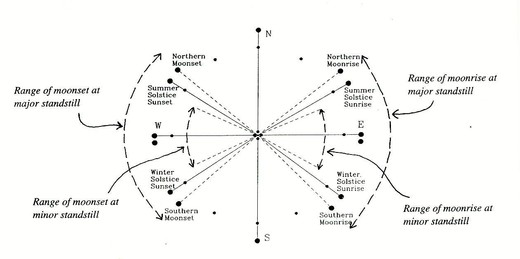Where will the moon be tonight? That a simple question but it can have a complicated answer. The simplest would be, "about 15 degrees behind where it was last night." The more complicated ones start with "depends what year it is." Today I got curious so I searched around and found a web-page that scratched my itch and gave me a new idea.
The page is on the University of Massachusetts Amherst's website, and is called "MOON TEACHINGS FOR THE MASSES". It has nice diagrams like this:

and this:

that help explain the paths of the Sun and Moon across the sky.
The easiest way to track the paths of the Sun and Moon is by the positions where they rise and set on the horizon. These positions swing back and forth like a pendulum, north and south and back again, according to where they are in their cycle around the Earth (remember, the Sun's cycle lasts 365 days, while the moon's is only 29.5 days).
On the summer and winter solstices, the Sun will rise at its maximum northern position or maximum southern position. This corresponds to the point of the pendulum swing where it comes to a rest and turns around. On the equinoxes, the sun will rise and set on the cardinal points E and W. This corresponds to the middle of the swing, where the pendulum is moving at its maximum speed.
At both equinoxes, the Sun reaches a maximum declination (height above the horizon) of 90° minus your latitude. The max altitude at the solstices is 90° minus your latitude, plus the tilt of the Earth 23.5° in the summer and minus 23.5° — tilt in the other direction — in the winter. If your home latitude is greater than 90° - 23.5° = 76.5° degrees, then in the winter the sun will have a maximum altitude of less then zero degrees and you get to experience the 24 hour darkness of polar night!
In Shanghai we are at a latitude of 31.2° and HeavensAbove says the sun will reach a max altitude today of 37° at 11:42 this morning. This makes sense because we're getting close to December 22, the winter solstice, when the sun will reach an altitude of just 90° - 23.5° - 31.2° = 35.3°, it's lowest path across the sky this year. This is also the well-known shortest day of the year. On December 23 the sun will rise just a bit more northerly and earlier as it begins its return to summer.
The moon goes through a similar cycle but much more quickly. The Moon's "equinoxes" and "solstices" happen every two weeks! (29.5 days / 2) Since the Moon's orbit is tilted at 5° from the plane of the Earth's orbit around the Sun, we see its maximum and minimum altitudes vary from the Sun's by that amount. Furthermore, the moon has a noticeable 18.6-year cycle due to relatively quick precession, meaning that the Moon's "pendulum" swings wider than the Sun's by 5° every 9.3 years, and shorter than the Sun's by 5° after another 9.3 years. Stack onto this that the Sun outshines the Moon when both are in the sky — the Moon is mostly visible only at night — and this means that what you see in the sky can range from high moons to low moons, to moons of different phases, to no moons at all!
Currently, we are just starting the backwards motion of the Moon's 18-year pendulum swing: in 2006 the Moon was ranging a full 23.5° + 5° = 28.5° above and below the Sun's path, but now in 2009 we are swinging back towards a minimum and, for example, beating it at most by 25.8° tomorrow night, December 2, for a full altitude of 90° - 31.2° + 25.8° ≈ 84.6° (HeavensAbove says 84.5°). This is why you may have noticed the Moon being so high in the sky for the past few days, not to mention that we're one day away from the full moon! But remember the moon's quick cycle: just two weeks from tomorrow the Moon complete half of its cycle and have a max altitude of only 90° - 31.2° - 25.8° ≈ 33.0°. And two weeks later we'll be back to a bit less than the current 84.6°, as the moon continues its precession.
All of this to say that it would be a neat project to map the rises and settings of the Sun every day to see the progression from solstice to equinox and back again. Not that I'm contemplating setting up a new Stonehenge in my backyard (thought a mini-one would be nice), but it might make a good addition to the observatory or school garden.
(So Dad, to answer your question: the moon is high in in the sky because ➀ we're coming off of a precession maximum, ➁ it happens every 29.5 days, and ➂ it's happening at the same time as the full-moon so it's particularly bright.)
(Disclaimer: these are the study notes of an amateur astronomer, so don't take anything here for granted. Follow my links to more authoritative sources.)


0 Comments:
Post a Comment
« Home
Post a Comment